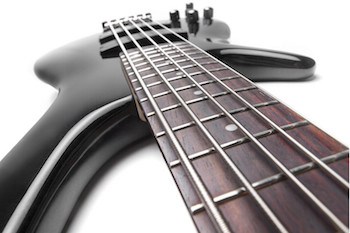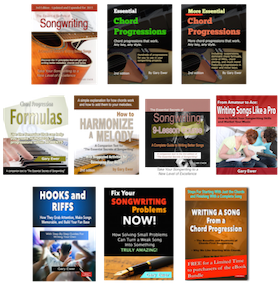Working out a catchy bass line gives you several options for the chords you might use to accompany it.
_____________
 It can be an interesting idea to generate a chord progression by starting with what you’d like to hear in the bass. There are several possibilities for every bass line you create, and that’s what can make things interesting.
It can be an interesting idea to generate a chord progression by starting with what you’d like to hear in the bass. There are several possibilities for every bass line you create, and that’s what can make things interesting.
If your bass line moves mainly by step (i.e., one note moving to an adjacent one), the least satisfying solution is to treat each bass note as if it’s a root. For example, if you like this bass line: C D Eb F Eb D C, treating those as if they’re chord names and not just bass notes gives you a progression where everything moves in parallel, and it’s not terribly satisfying.
_____________
 If you’re relying on instincts alone, you could be missing out on great opportunities to take your songwriting to a much higher level. Let “The Essential Secrets of Songwriting” eBook Bundle packages show you how to polish your technique. Get the discount price: Read more…
If you’re relying on instincts alone, you could be missing out on great opportunities to take your songwriting to a much higher level. Let “The Essential Secrets of Songwriting” eBook Bundle packages show you how to polish your technique. Get the discount price: Read more…
______________
So for most bass lines, you’ll want some of the bass notes to be the root of a chord, while other bass notes to be some other chord tone other than the root. That means that your progression will likely be a combination of root-position chords and inverted (slash) chords.
If you don’t know what we’re discussing when we talk about root position and inversions, read this article. It should clear things up.
Let’s say that you like the following bass line: C F G A F Eb C
Here is a short list of chord progressions that use those notes as bass notes, and then followed by a description of how to create your own chords from a bass line.
- C F G Am Fm Eb C
- C Dm/F C/G F/A F Eb C
- C Bb/F C/G Am Bb/F Ab/Eb C
You see that the first progression uses all root position chords, with the only altered chord being the Fm, just for some added flavour. The second progression uses a few inversions, and the third one is the most “fragile” one, using several second inversion chords.
When creating your own chord progressions from a bass line, here are some tips:
- Let your ears be your guide. If you’ve got a bass line that you like, keep playing it over and over, and eventually chord choices will start to form in your musical brain.
- Keep the tonic chord as a focal point. You can do anything you want with chords, but in most music from pop genres, the tonic chord (i.e., the one representing the key of your song) is going to want to be the main chord of interest, the one you keep returning to.
- Incorporating leaps of 4ths and 5ths in adjacent chord ROOTS will strengthen a progression. You’ll notice in the second progression that even though the 3rd to the 4th bass note is a 2nd (G to A), it gets some strength by using the chords C to F.
- Try to limit altered chords. An altered chord is one that doesn’t normally exist in your key of choice. Using lots of altered chords pulls the music away from your chosen key, and then it’s hard to get back. Good progressions often use altered chords (and the Eb as a second-last bass note means you’ll have to use at least one), but don’t use so many that the key of the music is difficult or impossible to figure out.
______________
 Written by Gary Ewer. Follow on Twitter.
Written by Gary Ewer. Follow on Twitter.
 “The Essential Secrets of Songwriting” eBook Bundle packages look at songwriting from every angle, and have been used by thousands of songwriters. How to use chords, write melodies, and craft winning lyrics. Get the discount price on the 10-eBook deluxe bundle.
“The Essential Secrets of Songwriting” eBook Bundle packages look at songwriting from every angle, and have been used by thousands of songwriters. How to use chords, write melodies, and craft winning lyrics. Get the discount price on the 10-eBook deluxe bundle.










Reblogged this on I Write The Music.